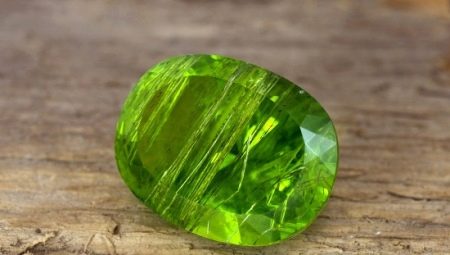The natural mineral chrysolite, which has an unusual green or yellow-green color, is very popular as a basis for creating various accessories, jewelry, and as an element of decor, and even as a charm against adversity. In English-speaking countries, the stone is often called a peridot. The natural mineral in the Middle East is highly regarded, where its unique coloring is considered noble. And the first mention of chrysolite can be found in biblical sources, not to mention the literature, where this stone is found from antiquity to the present day.
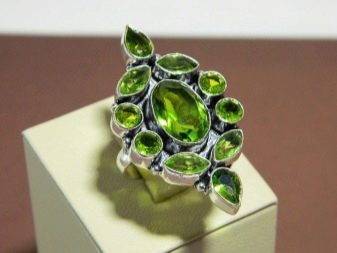
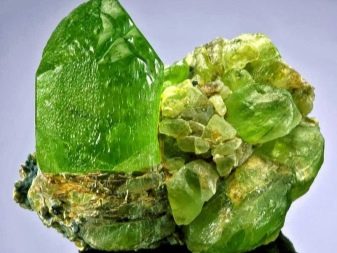
What it is?
Natural stone chrysolite has a hypnotic golden green color, due to which it is often confused with emerald. Despite some similarities, these transparent crystals are still very different from each other. The color of the stone depends on the conditions in which its formation took place. In most cases, it is yellow-green or emerald, but can acquire a brown tint due to the presence of metal impurities - iron, chromium, nickel.
Chrysolite looks very decorative due to its main characteristic - light refractive index, it is quite high. Ornamental mineral, the description of which always makes you want to see it with your own eyes, when properly cut, is a very effective addition to products made of precious metals.
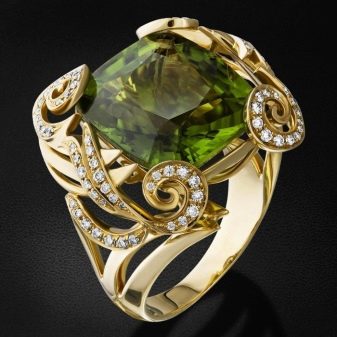
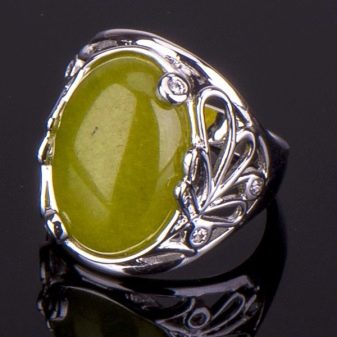
Chrysolite nuggets are quite rare in nature. They are natural companions of diamonds and can form in kimberlites, where ultra-strong crystals form. In addition, they often enter rock masses called olivine.
We can say that these stones are related and similar in structure.
Chrysolite mining, carried out in volcanic rocks, allows us to talk about the influence of magmatic processes on its formation. Surprisingly, this mineral can also be found outside the Earth. Its traces were repeatedly found in samples of lunar rock and on fragments of meteorites. But the size of nuggets, even in earthly terms, is not too large.
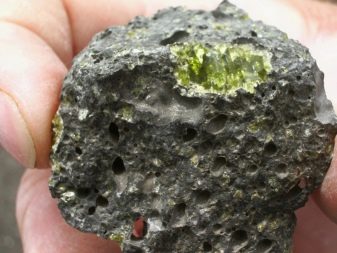
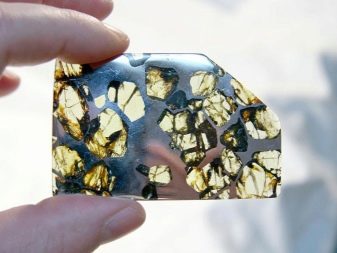
The largest known faceted mineral has a weight of 310 carats. And the most common stone size is less than 3 carats. The first historically significant product made of chrysolite can be called the lens of the emperor Nero, through which, according to legend, he surveyed the Eternal City, which he had burnt to ashes - Rome. Today, this relic is kept in the Vatican.
The cost of chrysolite largely depends on its cut. The cheapest one is the “pear”, which allows you to buy jewelry with this mineral for several thousand rubles. The most expensive option - more than 12,000 rubles per carat, refers to stones cut in the form of a perfectly even circle. Also, the final price of a stone is affected by its purity.
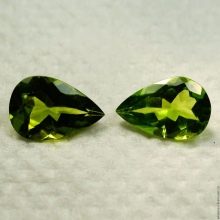


Precious or semiprecious stone?
Answering this question is harder than it sounds. According to the current classification, it belongs to the category of second-class precious stones (III order). To obtain such a status, the mineral has everything necessary - a sufficiently high hardness, gloss, and optical effects.
But at the same time, chrysolite is an ornamental stone. That is, in large quantities it can be used for the manufacture of interior decor items, as well as for combination with silver as a frame. Chrysolite crystals are not highly valuable, but are popular due to the variety of optical effects observed in them.
Due to the inclusion of additional components - mica, spinel, magnetites, chromites, the transparency of the mineral varies greatly. But it is precisely this factor that makes it possible to observe the effect of the “cat's eye”, irisation - radiance under artificial lighting, opalescence and other interesting and unusual phenomena characteristic of chrysolite.
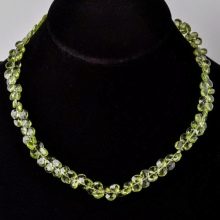
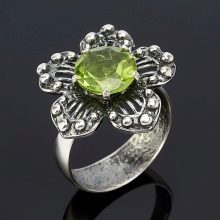
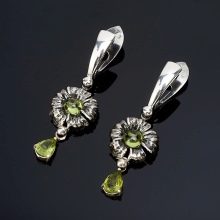
Varieties
The very concept of “chrysolite” is inextricably linked with a stone known as olivine. It is he who is as close as possible to a precious analogue in composition. The English name peridot is also commonly used. But what is considered more true - chrysolite and its varieties olivine and peridot, or is it still a general group of minerals?
In any case, each of these options is characterized by a green color.
Raw olivine is quite difficult to distinguish from other minerals in this group. But since 1968, gemologists have approved and apply the following classification: chrysolite is called only a transparent stone that has a green or golden hue.
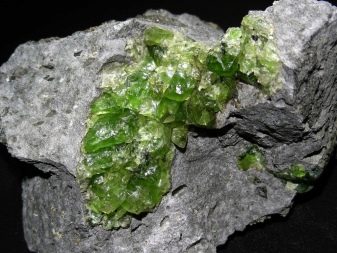
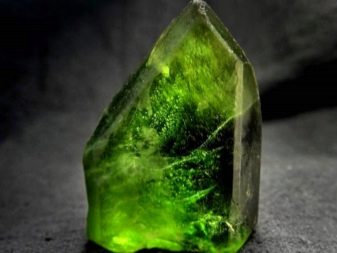
As for the confusion, it is also added by the fact that collectors and popular literature often classify minerals with a completely different chemical composition in this category. Chrysolite is also called the so-called "Ural emerald", which is actually a green pomegranate. Gemologists are against such an extension of the classification, but such incidents are not uncommon in history. So, Saxon chrysolite was called topaz, Brazilian - chrysoberyl.
The mineral received its original name in ancient Greek. Canonically, the color of the stone is olive green, soft, interspersed with yellow, brown, brown and golden. The most valuable varieties of chrysolite are only two:
- the mass obtained manually in the reservations of the Apache Indians has a diameter of up to 15 mm;
- with the effect of asterism - the star-shaped internal structure allows it to create an unusual play of light with a completely smooth surface.
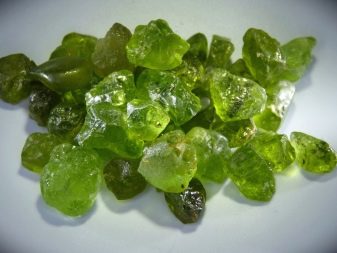

How to distinguish natural stone from fake?
Natural chrysolite is quite popular among scammers seeking to fake it. Sometimes fraud can only be recognized through laboratory analysis, especially when it comes to fraud with cheaper types of minerals of natural origin. Possible errors can be prevented by requiring a special certificate. In addition, it is worth paying attention to the following points.
- When warming in the palms natural mineral stays cold. A plastic fake is rapidly gaining heat.
- When viewing in the sun a bifurcation effect forms through the stone.
- Glitter surface. In real chrysolite, it is saturated, oily.
- Sizes and weight. Stones over 3 carats and with decent purity, transparency, are extremely rare in free sale.
- When pressed hard no traces should remain on the stone. Plastic will inevitably scratch.
- The stones from Sri Lanka, for the most part, are simply fragments of a bottle of glass rolled into water. The falsification of chrysolite in this country is put on stream. But with a careful visual inspection, a fake can be detected due to uneven coloring. A natural mineral will not have this effect.
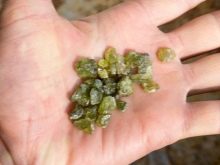
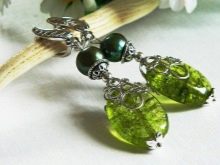
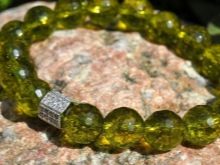
Given all these points, you can avoid the trouble when buying chrysolite and products with it.
Where is it mined?
Chrysolite is a natural mineral found in many countries of the world. Its production is successfully conducted in Australia, Tanzania, South Africa, Brazil, Pakistan and Myanmar. There are also deposits in Sri Lanka, but the proportion of counterfeit coming from there is very high. During archaeological excavations, the mineral is often found in historically significant places - Alexandria, Jerusalem, in the cities of Greece.
Egypt has the most popular mine. It is based on the island of Zebergad in the Red Sea. Also, stone is mined in the United States in the state of Arizona.
Russian chrysolite deposits are concentrated in places of traditional diamond mining - in Yakutia and the Krasnoyarsk Territory. Also, stone for jewelry is mined in the Murmansk region on the territory of the Kovdor mountain range. The Ural chrysolite mentioned by amateurs is not an island silicate, but refers to a subspecies of pomegranates.
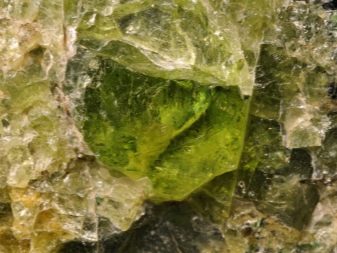
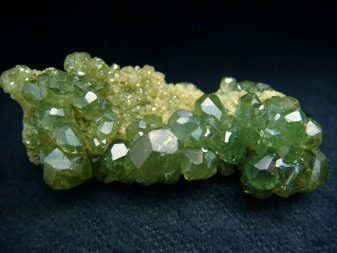
The properties
All existing properties of chrysolite stone are usually considered at once in several directions. Indeed, in addition to the objective characteristics associated with the density, hardness, composition of a natural mineral, there are also criteria for subjective assessment. For example, the healing properties that have been known since ancient times. Attribute to the stone and mystical characteristics. They are mainly associated with its unusual properties, a mysterious radiance and the ability to transform under bright electric lighting, like a diamond.

Physicochemical
The main physicochemical characteristics of chrysolite are associated with its composition. The stone is based on iron-magnesium orthosilicate, respectively, the volumes of metal inclusions affect not only transparency, but also the color scheme. Copper inclusions give saturated emerald greens, iron is responsible for yellow and brown shades, the inclusion of nickel and chromium is also acceptable.
Chrysolite is a rather fragile mineral: its hardness reaches only 7 points on the Mohs scale. The density of the stone is 3.3 g / cm3, which makes it easy to polish and cut it. Carefully processed peridot gains a peculiar glass luster. The natural structure of the stone makes it vulnerable to acids, it easily dissolves in them, and in contact with aggressive environments can be damaged.
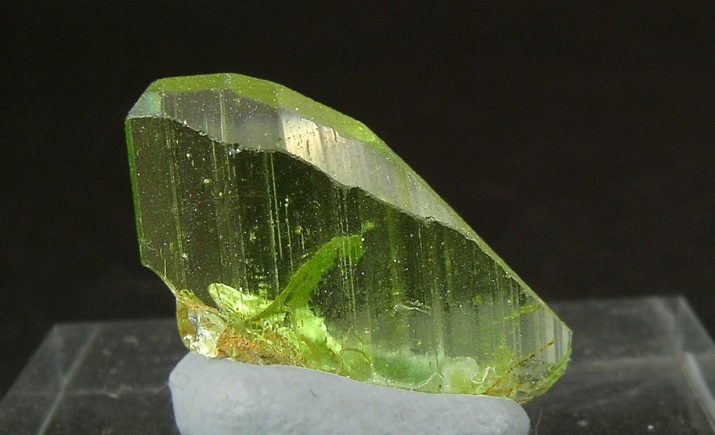
It is customary to subject classical pure chrysolites to diamond, step or emerald cut, showing all its characteristic properties. Star crystals and stones with the effect of "cat's eye" are subjected to processing "cabochon".
The birefringence property makes it possible to obtain a bifurcated image when viewed through the thickness of a mineral.
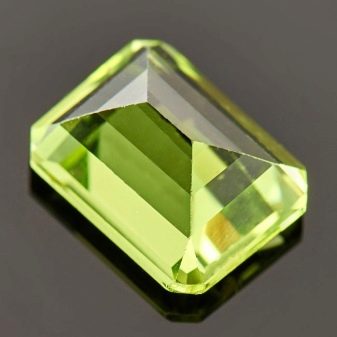
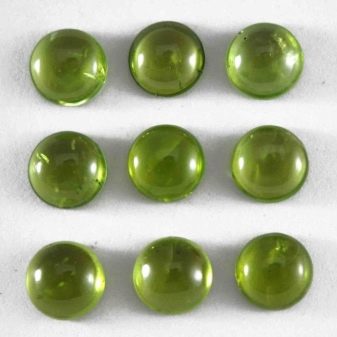
Medical
There is no official scientific evidence that chrysolite has any healing abilities. But over the centuries, its use was considered beneficial for women who have problems with childbearing and the health of the reproductive system as a whole. Lithotherapists of the past attributed to the stone the ability to relieve abdominal pain and cramps, relieve toxicosis.

Modern healers find much wider use for the mineral. It is suggested that chrysolite can:
- beneficial effect on the organs of vision;
- able to relieve pain, eliminate discomfort in muscles and joints;
- regulate the work of the gastrointestinal tract, ensuring the normalization of the processes occurring in it;
- positively affect the health of the cardiovascular system;
- purify human blood from toxins;
- improve hormonal levels, improve the action of the endocrine system;
- strengthen immunity, protect against viral infections;
- relieve spasms, regulate the nervous system;
- establish psychological well-being, eliminate fears, relieve insomnia;
- accelerate the cure of stuttering, nervous tic;
- help in the regeneration of organs and tissues after surgery;
- facilitate labor;
- relieve migraines.



As a rule, lithotherapists advise wearing a mineral closer to the body, choosing a stone according to its energy potential. It is also important to pay attention to the fact that taking crushed stone powder or wipes and ointments made on its basis can be hazardous to health.
Apply such treatment methods with great caution.
Magical
Chrysolite is one of the minerals that is traditionally credited with magical properties. So that the stone can manifest them, it should be properly used and worn. Before important changes occur, it is possible to make such a talisman, having previously determined its significance for a person. Energetically, peridot is considered a positively charged mineral, for a long time clergy used it in their rituals. Today, chrysolite is more often considered as a personal talisman that can protect, preserve, give a good mood and calm.
For women, chrysolite has long been considered a powerful weapon in the struggle for interest of the opposite sex. A mineral framed by metal - in the form of a ring, brooch, cameo or earrings, increases sexual desire, the attractiveness of its owner.
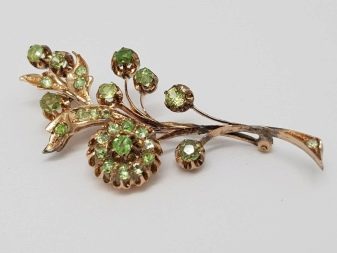

Olivine and chrysolite are traditionally classified as stones useful to thinkers, as well as people associated with jurisprudence or law.
With his help, they acquired an oratory gift and self-confidence, drove away doubts. It is believed that the stone helps its owner to avoid erroneous decisions or judgments.
In the trading environment, peridot gained particular popularity in the Middle Ages. It was then that he was considered a talisman, patronizing merchants. It was believed that the constant wearing of a stone will increase profits, protect against obviously unprofitable or failed transactions, and prevent the loss or theft of goods.
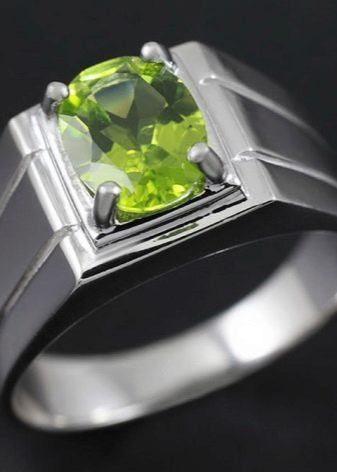

The magical influence of stone today is considered in many areas and areas of activity.
- In love chrysolite promises the acquisition of true feelings, helps to gain attention and love of the desired object.
- In friendship promises to save from deception and betrayal. Peridot can be used to make paired jewelry that will hold friendships for many years to come.
- In cultivation this mineral helps to achieve a lot.Chrysolite is able to save its owner from envy and torment, defeats phobias, helps to find peace of mind. The stone is recommended to be worn constantly during the period of depression, despondency, nervous shock.
- In resolving litigation. Since chrysolite is considered a stone of justice, it can help resolve the most protracted litigation. The mineral will restore mental health, permanently relieve any torment and doubt in the justice of justice.
- In career aspirations. The energy of chrysolite is such that it contributes to the manifestation of the best that is already in a person. If the field of activity is chosen correctly, only his own will can stop the owner of the stone from taking off the career ladder.


People practicing magic rituals recommend peridot as a means of imposing someone else's will. The mineral helps to get rid of love obsessions, misconceptions about the actions of friends and relatives, clarifies thoughts.
It is believed that it contributes to the awakening of extrasensory gifts.

Who is it for?
Before you get a decoration of natural stone, it is worthwhile to find out who suits this mineral. It is dangerous to wear amulets and talismans that are opposite in energy. Indeed, in this case, the confrontation can easily deprive the owner of the decoration of forces, immerse him in gloom and apathy. Astrological recommendations should be taken into account. In particular, chrysolite is perfect as a talisman for representatives of the following zodiac signs.
- Sagittarius. Its fiery temper requires taming, and the mineral will perfectly cope with this task. By curbing anger, he will help to improve the overall life position of his owner, help him win the love of loved ones, achieve promotion.
- Libra. The representative of the air element often "soars in the clouds" and is not too serious about marriage ties. Changes in life will help bring a talisman that increases responsibility and eliminates doubts about the fidelity of decisions made.
- Fishes. Eternally in doubt, representatives of the water element simply need an amulet with which you can gain self-confidence. Delivering its owner from melancholy, excessive emotionality, the stone will give peace and peace in the soul to a person who is distinguished by excessive suspiciousness.


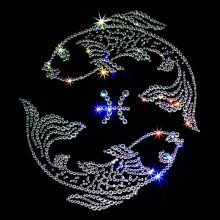
Despite the fact that chrysolite jewelry is not suitable for everyone, people close to the world of astrology and magic assure: it’s definitely worth buying it if there is a move ahead, a major financial transaction, a job change. In this case, at the end of the specified event, the product with the stone simply goes to the storage place - you do not have to wear it constantly.
Care and storage
Chrysolite jewelry is quite popular and widespread. But improper care of them is to the detriment of the precious mineral. To comply with all the rules, the following precautions should be kept in mind.
- Due to the increased fragility of the stone, the jewelry - earrings, pendant, brooch, ring, should be protected from mechanical damage. Their cleaning by hard abrasive compounds is excluded. It is necessary to protect the mineral from falls, shocks.
- Removal of surface contaminants from the stone should be done using soap foam and a soft cloth. Rinse with plain water.
- The process of drying jewelry with chrysolite after processing and removing contaminants requires placing the stone away from exposure to the sun. Drying is not suitable, as heating can adversely affect the condition of the stone. To get rid of moisture, use lint-free soft wipes.
- If the jewelry - beads, necklace, diadem, ring, earrings, is not worn constantly, you must take care to follow the rules for its storage. When placed together with other products, an individual velvet cover is necessarily used. But it is best to pre-order a separate case.
This will avoid the formation of microscopic cracks inside the stone.
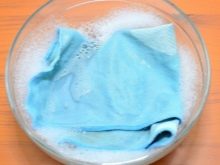


If all the rules are followed, chrysolite products will retain their expressive color and impeccable shine for a long time, even after decades remaining a magnificent piece of jewelry.
For more on chrysolite, see the next video.
